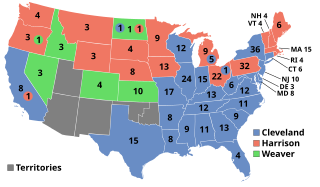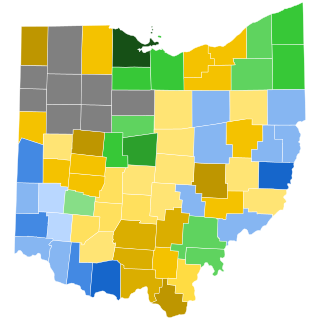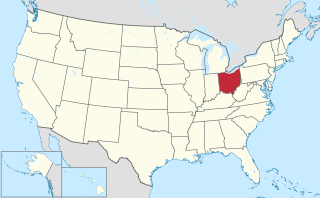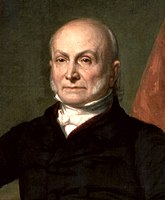
The 1876 United States presidential election was the 23rd quadrennial presidential election, held on Tuesday, November 7, 1876. Incumbent Republican president Ulysses S. Grant declined to run for a third term, so the party chose Rutherford B. Hayes, the governor of Ohio, as its nominee. The Democratic Party nominated New York governor Samuel J. Tilden as their nominee. It was one of the most contentious presidential elections in American history. Its resolution involved negotiations between the Republicans and Democrats, resulting in the Compromise of 1877, and on March 2, 1877, the counting of electoral votes by the House and Senate occurred, confirming Hayes as president. It was the second of five U.S. presidential elections in which the winner did not win a plurality of the national popular vote. This is the first time it happened since 1824, and the first and only time that a candidate won an overall majority in the popular vote but did not win the presidency.

The 1824 United States presidential election was the tenth quadrennial presidential election. It was held from Tuesday, October 26 to Thursday, December 2, 1824. Andrew Jackson, John Quincy Adams, Henry Clay and William Crawford were the primary contenders for the presidency. The result of the election was inconclusive, as no candidate won a majority of the electoral vote. In the election for vice president, John C. Calhoun was elected with a comfortable majority of the vote. Because none of the candidates for president garnered an electoral vote majority, the U.S. House of Representatives, under the provisions of the Twelfth Amendment, held a contingent election. On February 9, 1825, the House voted to elect John Quincy Adams as president.

The 1828 United States presidential election was the 11th quadrennial presidential election. It was held from Friday, October 31 to Tuesday, December 2, 1828. It featured a repetition of the 1824 election, as President John Quincy Adams of the National Republican Party faced Andrew Jackson of the Democratic Party. Both parties were new organizations, and this was the first presidential election their nominees contested. This election saw the second rematch in presidential history, something that would not occur again until 1840.

The 1832 United States presidential election was the 12th quadrennial presidential election, held from Friday, November 2 to Wednesday, December 5, 1832. Incumbent president Andrew Jackson, candidate of the Democratic Party, defeated Henry Clay, candidate of the National Republican Party.

The 1892 United States presidential election was the 27th quadrennial presidential election, held on Tuesday, November 8, 1892. In the fourth rematch in American history, former Democratic President Grover Cleveland defeated incumbent Republican President Benjamin Harrison. Cleveland's victory made him the first and, to date, the only person in American history to be elected to a non-consecutive second presidential term. It was also the first of two times incumbents were defeated in consecutive elections—the second being Jimmy Carter's defeat of Gerald Ford in 1976, followed by Carter's subsequent loss to Ronald Reagan in 1980. It was the first election since 1856 in which one former president ran against the incumbent president, an event not repeated until 1912.

The 1972 United States presidential election was the 47th quadrennial presidential election held on Tuesday, November 7, 1972. Incumbent Republican president Richard Nixon defeated Democratic U.S. senator George McGovern in a historic-level landslide.

The following is a summary of the electoral vote changes between United States presidential elections. It summarizes the changes in the Electoral College vote by comparing United States presidential election results for a given year with those from the immediate preceding election. It tracks those states which changed their support between parties as well as changes resulting from other factors, such as reapportionment.

The 1832 Democratic National Convention was held from May 21 to May 23, 1832, in Baltimore, Maryland. In the first presidential nominating convention ever held by the Democratic Party, incumbent President Andrew Jackson was nominated for a second term, while former Secretary of State Martin Van Buren was nominated for vice president.

The 1832 United States presidential election in Pennsylvania took place between November 2 and December 5, 1832, as part of the 1832 United States presidential election. Voters chose 30 representatives, or electors to the electoral college, who voted for president and vice president.

The 1828 United States presidential election in Pennsylvania took place between October 31 and December 2, 1828, as part of the 1828 United States presidential election. Voters chose 28 representatives, or electors to the Electoral College, who voted for President and Vice President.

The 1824 United States presidential election in Ohio took place between October 26 and December 2, 1824, as part of the 1824 United States presidential election. Voters chose 16 representatives, or electors to the Electoral College, who voted for President and Vice President.

The 1828 United States presidential election in Kentucky took place between October 31 and December 2, 1828, as part of the 1828 United States presidential election. Voters chose 14 representatives, or electors to the Electoral College, who voted for President and Vice President.

The 1828 United States presidential election in Missouri took place between October 31 and December 2, 1828, as part of the 1828 United States presidential election. Voters chose three representatives, or electors to the Electoral College, who voted for President and Vice President.

The 1828 United States presidential election in New York took place between October 31 and December 2, 1828, as part of the 1828 United States presidential election. Voters chose 36 representatives, or electors to the Electoral College, who voted for President and Vice President. For this election, New York used the Congressional District Method of choosing electors, with 34 of its electors being chosen by the winner in each of the state's congressional districts, and the remaining two being chosen by the first 34 electors. Jackson won 18 congressional districts while Adams won 16. This election marks the first time New York did not choose its electoral votes through its State Legislature.

The 1828 United States presidential election in Tennessee took place between October 31 and December 2, 1828, as part of the 1828 United States presidential election. Voters chose 11 representatives, or electors to the Electoral College, who voted for President and Vice President.

The 1832 United States presidential election in Ohio took place between November 2 and December 5, 1832, as part of the 1832 United States presidential election. Voters chose 21 representatives, or electors to the Electoral College, who voted for President and Vice President.

The 1828 United States elections elected the members of the 21st United States Congress. It marked the beginning of the Second Party System, and the definitive split of the Democratic-Republican Party into the Democratic Party and the National Republican Party. While the Democrats cultivated strong local organizations, the National Republicans relied on a clear national platform of high tariffs and internal improvements. Political scientists such as V.O. Key, Jr. consider this election to be a realigning election, while political scientists such as James Reichley instead see the election as a continuation of the Democratic-Republican tradition. Additionally, this election saw the Anti-Masonic Party win a small number of seats in the House, becoming the first third party to gain representation in Congress.

Following is a table of United States presidential elections in Ohio, ordered by year. Since its admission to statehood in 1803, Ohio has participated in every U.S. presidential election.

The 1856 United States presidential election in New York took place on November 4, 1856, as part of the 1856 United States presidential election. Voters chose 35 representatives, or electors to the Electoral College, who voted for president and vice president.

The 1916 United States presidential election in Ohio was held on November 7, 1916. State voters chose 24 electors to the Electoral College, who voted for president and vice president.























